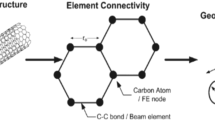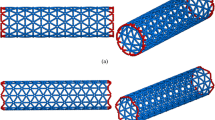Abstract
The mechanical properties of nanostructures are a researcher’s favorite topics. In the meantime, the mechanical and physical properties of the two dimensional structures and the nanotubes have attracted greater attention due to their wide application. Si (Si) nanotubes are structures consisting of Si atoms that are arranged as honeycombs. This structure has created some special properties in Si nanotubes. In this paper, Young’s modulus values and stress strain diagrams of Si nanotubes are investigated using molecular dynamics method and the Tersoff potential. Then, the changes effect of size and dimension was investigated for a closer look. For this purpose, the effect of nanotube diameter, length, and chirality shift from zigzag to armchair were studied. The results showed that the fracture stress of nanotube decreased with increasing the length of Si nanotube. It was also shown that the armchair structure was stronger than the zigzag. The effect of diameter change on the mechanical properties was also investigated and it was observed that no specific order could be found between the diameter changes with the Si nanotube strength. The results were in good agreement with other studies.
Similar content being viewed by others
Data Availability
The datasets generated and/or analyzed during the current study are not publicly available but are available from the corresponding author on reasonable request
References
Huang Y, Chattopadhyay S, Jen Y, Peng Y, Liu T, Hsu Y, Pan C, Lo H, Hsu C, Chang Y, Lee C, Chen K, Chen L (2007) Improved broadband and quasiomnidirectional anti-reflection properties with biomimetic silicon nanostructures. Nature Nanotech 2:770–774
Lee LP, Szema R (2005) Inspirations from biological optics for advanced photonic systems. Science. 310:1148–1150
Vukusic P, Sambles JR (2003) Photonic structures in biology. Nature. 424:852–855
Parker AR, Townley HE (2007) Biomimetics of photonic nanostructures. Nature Nanotech. 2:347–353
Potyrailo R, Ghiradella H, Vertiatchikh A, Dovidenko K, Cournoyer J, Olson E (2007) Morpho butterfly wing scales demonstrate highly selective vapour response. Nature Photon 1:123–128
Neinhuis C, Barthlott W (1997) Characterisation and distribution of water-repellent, self-cleaning plant surfaces. Ann Bot 79:667–677
Ghiradella H, Aneshansley D, Eisner T, Silberglied RE, Hinton HE (1972) Ultraviolet reflection of a male butterfly: interference color caused by thin-layer elaboration of wing scales. Science. 178:1214–1217
Aizenberg J, Tkachenko A, Weiner S, Addadi L, Hendler G (2001) Calcitic microlenses as part of the photoreceptor system in brittlestars. Nature. 412:819–822
Bernhard CG (1967) Structural and functional adaptation in a visual system. Endeavour. 26(98):79–84
Singh A, Chaudhury S, Chanda M, Sarkar CK (2020) Split gated silicon nanotube FET for bio-sensing applications. IET Circuits, Devices & Systems 14(8):1289–1294
Hibst N, Steinbach AM, Strehle S (2016) Fluidic and electronic transport in silicon nanotube biosensors. MRS Advances 1(56):3761–3766
Mu C, Zhao Q, Xu D, Zhuang Q, Shao Y (2007) Silicon nanotube array/gold electrode for direct electrochemistry of cytochrome c. J Phys Chem B 111(6):1491–1495
Camilli L, Passacantando M (2018) Advances on sensors based on carbon nanotubes. Chemosensors. 6(4):62
Kunjie L, Wang W, Cao D (2011) Novel chemical sensor for CO and NO: silicon nanotube. J Phys Chem C 115(24):12015–12022
Ji X, Wang H, Song B, Chu B, He Y (2018) Silicon nanomaterials for biosensing and bioimaging analysis. Frontiers in chemistry 6:38
Wen, Z., Lu, G., Mao, S., Kim, H., Cui, S., Yu, K., ... & Chen, J. "Silicon nanotube anode for lithium-ion batteries", Electrochem Commun, 29, 67–70 (2013)
Park M, Kim M, Joo J, Kim K, Kim J, Ahn S, Cui Y, Cho J (2009) Silicon nanotube battery anodes. Nano Lett 9(11):3844–3847
Tesfaye AT, Gonzalez R, Coffer JL, Djenizian T (2015) Porous silicon nanotube arrays as anode material for Li-ion batteries. ACS Appl Mater Interfaces 7(37):20495–20498
Wu H, Chan G, Choi J, Ryu I, Yao Y, McDowell MT, Lee S, Jackson A, Yang Y, Hu L, Cui Y (2012) Stable cycling of double-walled silicon nanotube battery anodes through solid electrolyte interphase control. Nature Nanotech. 7:310–315
Jia Y, Cao A, Bai X, Li Z, Zhang L, Guo N, Wei J, Wang K, Zhu H, Wu D, Ajayan PM (2011) Achieving high efficiency silicon - carbon nanotube heterojunction solar cells by acid doping. Nano Lett 11(5):1901–1905
Jeong H, Song H, Pak Y, Kwon IK, Jo K, Lee H, Jung GY (2014) Enhanced light absorption of silicon nanotube arrays for organic/inorganic hybrid solar cells. Adv Mater 26(21):3445–3450
Ambika R, Srinivasan R (2016) Performance analysis of n-type junctionless silicon nanotube field effect transistor. J Nanoelectron Optoelectron 11(3):290–296
Fahad HM, Hussain MM (2013) High-performance silicon nanotube tunneling FET for ultralow-power logic applications. IEEE Trans Electron Devices 60(3):1034–1039
Tekleab D (2014) Device performance of silicon nanotube field effect transistor. IEEE Electron Device lett 35(5):506–508
Fahad HM, Smith CE, Rojas JP, Hussain MM (2011) Silicon nanotube field effect transistor with core–shell gate stacks for enhanced high-performance operation and area scaling benefits. Nano Lett 11(10):4393–4399
Chen JF, Ding HM, Wang JX, Shao L (2004) Preparation and characterization of porous hollow silica nanoparticles for drug delivery application. Biomaterials. 25(4):723–727
Chen Y, Aslanoglou S, Murayama T, Gervinskas G, Fitzgerald LI, Sriram S, Tian J, Johnston AP, Morikawa Y, Suu K, Elnathan R (2020) Silicon-nanotube-mediated intracellular delivery enables ex vivo gene editing, Adv Mat 32(24):2000036
Yoo J, Kim J, Jung YS, Kang K (2012) Scalable fabrication of silicon nanotubes and their application to energy storage. Adv Mater 24(40):5452–5456
Chen X, Li H, Yan Z, Cheng F, Chen J (2019) Structure design and mechanism analysis of silicon anode for lithium-ion batteries. Sci China Mat 62(11):1515–1536
Sun Y, Liu N, Cui Y (2016) Promises and challenges of nanomaterials for lithium-based rechargeable batteries. Nat Energy 1(7):16071
Yang Y, McDowell MT, Jackson A, Cha JJ, Hong SS, Cui Y (2010) New nanostructured Li2S/silicon rechargeable battery with high specific energy. Nano Lett 10(4):1486–1491
LIU DL, LIU MX, Hu T, Wang XW, Su JT (2010) Advances in research on silicon nanotubes drug delivery systems. Progress in Pharmaceutical Sciences, p 10
Lan, J. Cheng, D. Cao,D. Wang, W. “Silicon nanotube as a promising candidate for hydrogen storage: from the first principle calculations to grand canonical Monte Carlo simulations”, J Phys Chem C, 112(14), pp. 5598–5604 (2008)
Pop E, Sinha S, Goodson KE (2006) Heat generation and transport in nanometer-scale transistors. Proceed IEEE 94(8):1587–1601
Li D, Wu Y, Kim P, Shi L, Young’s P (2003) Thermal conductivity of individual silicon nanowires. Appl Phys Lett 83(14):2934–2936
Chen J, Zhang G, Li B (2010) Remarkable reduction of thermal conductivity in silicon nanotubes. Nano Lett 10(10):3978–3983
Szczech JR, Jin S (2011) Nanostructured silicon for high capacity lithium battery anodes. Energy Environ Sci 4:56–72
Esfahani M, Alaca BE, Jabbari M (2019) Mechanical Properties of Honeycomb Nanoporous Silicon: A High Strength and Ductile Structure. Nanotechnology30(45)
Chan, C.K. Peng, H.L. Liu, G. McIlwrath, K. Zhang, C.F. Huggins, R.F. Cui,Y. “High-performance lithium battery anodes using silicon nanowires”, Nat Nanotechnol, 3(1), pp. 31–35 (2008)
Poizot P, Laruelle S, Grugeon S, Dupont L, Tarascon JM (2001) Searching for new anode materials for the Li-ion technology: time to deviate from the usual path. J Power Sources 97–8:235–239
Kasavajjula U, Wang CS, Appleby AJ (2007) Nano- and bulk-silicon-based insertion anodes for lithium-ion secondary cells. J Power Sources 163:1003–1039
Bai J, Zeng XC, Tanaka H, Zeng JY (2004) Metallic single-walled silicon nanotubes. Nat Acad Sci 101(9):2664–2668
Fagan SB, Mota R, Baierle RJ, Paiva G, da Silva AJJ, Fazzio J (2001) Stability investigation and thermal behavior of a hypothetical silicon nanotube. J Mol Struct Theochem 539:101–106
Palaria A, Klimeck G, Strachan A (2008) Structures and energetics of silicon nanotubes from molecular dynamics and density functional theory. Phys. Rev. B. 78(20):205315
Ranjbartoreh, Ali Reza, and Guoxiu Wang. Molecular dynamic investigation of mechanical properties of armchair and zigzag double-walled carbon nanotubes under various loading conditions Physics Letters A 374, no. 7 (2010): 969–974
San Paulo A, Bokor J, Howe RT, He R, Young’s P, Gao D, Carraro C, Maboudian R (2005) Mechanical elasticity of single and double clamped silicon nanobeams fabricated by the vapor-liquid-solid method. Appl Phys Lett 87(5):053111
Genoese A, Genoese A, Salerno G (2019) On the nanoscale behaviour of single-wall C, BN and SiC nanotubes. Acta Mech 230:1105–1128
Rapaport, D. “The art of molecular dynamics simulation”, Cambridge University press 1995, UK (2004)
Tersoff J (1986) New empirical model for the structural properties of silicon. Phys Rev Lett 56:632–635
Verma V, Dharamvir K, Jindal VK (2008) Structure and Elastic Modulii of Silicon Nanotubes. J Nano Res 2:85–90
Kang JW, Seo JJ, Hwang HJ (2002) Molecular Dynamics Study of Hypothetical Silicon Nanotubes Using the Tersoff Potential. J Nanosci Nanotechnol 2:687–691
Jeong Won Kang, Jae Jeong Seo, Ho Jung Hwang. “A Study on Silicon Nanotubes based on the Tersoff potential” (2002)
Lv P, Feng Y-y, Zhang P, Chen H-m, Zhao N, Feng W (2011) Increasing the interfacial strength in carbon fiber/epoxy composites by controlling the orientation and length of carbon nanotubes grown on the fibers. Carbon. 49(14):4665–4673
Acknowledgements
Not applicable
Code Availability
The LAMMPS package is free and open-source software.
Funding
This research was financially supported by a research grant from the University of Shahreza.
Author information
Authors and Affiliations
Contributions
Both authors contributed to the design and implementation of the research, to the analysis of the results and to the writing of the manuscript.
Corresponding author
Ethics declarations
Ethics Approval and Consent to Participate
Not applicable
Consent for Publication
Not applicable
Competing Interests
The authors declare that they have no competing interests
Additional information
Publisher’s Note
Springer Nature remains neutral with regard to jurisdictional claims in published maps and institutional affiliations.
Rights and permissions
About this article
Cite this article
Motamedi, M., Safdari, E. Effect of Diameter, Length, and Chirality on the Properties of Silicon Nanotubes. Silicon 14, 5527–5534 (2022). https://doi.org/10.1007/s12633-021-01332-9
Received:
Accepted:
Published:
Issue Date:
DOI: https://doi.org/10.1007/s12633-021-01332-9




